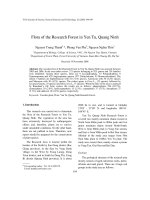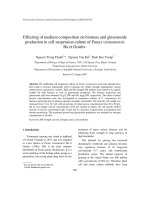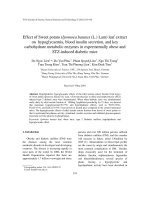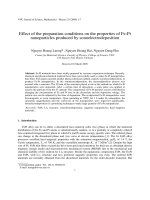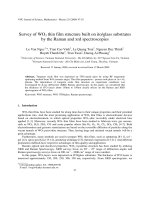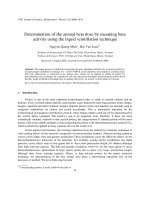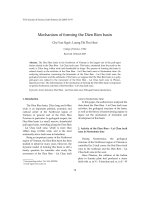Báo cáo "Vibration of corrugated cross-ply laminated composite plates " pot
Bạn đang xem bản rút gọn của tài liệu. Xem và tải ngay bản đầy đủ của tài liệu tại đây (153.96 KB, 8 trang )
VNU Journal of Science, Mathematics - Physics 23 (2007) 105-112
Vibration of corrugated cross-ply laminated composite plates
Khuc Van Phu
1,∗
, Le Van Dan
2
1
Military logistical Academy, 100 Hoang Quoc Viet, Cau Giay, Hanoi, Vietnam
2
Military Technical Academy
Received 5 October 2007
Abstract. In the present paper the governing equations for dynamical analysis of corrugated
cross-ply laminated composite plates in the form of a sin wave are developed based on the
Kirchoff-Love’s theory and the extension of Seydel’s technique. The problems of natural
vibration and forced vibration of a plate with various boundary conditions are studied. Effects of
factors as geometry dimensions, order of laminate as well as waved-amplitude on frequency of
natural vibration, amplitude of forced vibration of the corrugated cross-ply laminated composite
plates are also analysed.
1. Introduction
Laminated structures like corrugated cross-ply laminated composite plates in the form of sine
wave or fiber-reinforced composite plates are used widely in practice. Results of research about statical
and dynamical problems of laminated composite flat plates were presented mainly in Chia’s book [1].
A series of general articles about studying vibration of plates were reviewed by Sathyamoonthy [2].
However, the analysis of corrugated laminated composite plates in the form of sine wave has received
comparitively little attention.
Corrugated plates of wave form made of isotropic elastic material were considered as flat
orthotropic plates with corresponding orthotropic constants determined by the Seydel’s technique. In
this paper, the governing equations for dynamical analysis of corrugated cross-ply laminated composite
plates in the form of sine wave are established based on the Kirchoff-Love’s theory and the extension
of Seydel’s technique.
2. Constitutive equations of corrugated laminated composite plates
Consider a rectangular symmetrically laminated composite corugated plate in the form of sine
wave (see Fig. 1), each layer of which is an unidirectional composite material. Suppose the cross-
section line of corrugated plate in the plane (x, z) has the form of sine wave
z = H sin
πx
l
.
∗
Corresponding author. Tel.: 84-4-069577299.
E-mail:
105
106 Khuc Van Phu, Le Van Dan / VNU Journal of Science, Mathematics - Physics 23 (2007) 105-112
Linear displacement – strain relationships in the middle surface for a such corrugated plate are
[3]:
ε
x
=
∂u
∂x
− kw, χ
x
= −
∂
2
w
∂x
2
,
ε
y
=
∂v
∂y
, χ
y
= −
∂
2
w
∂y
2
,
γ
xy
=
∂u
∂y
+
∂v
∂x
, χ
xy
= −2
∂
2
w
∂x∂y
,
(1)
where u, v and w denote displacements of the middle surface point along x, y and z directions
respectively, ε
i
(i = 1, 2 and 6) are strains in the middle surface; k is the curvature of the cross-section
line in (x, z) plane, which is defined as:
k =
z
(1 + z
2
)
3/2
≈ z
= −H.
π
2
l
2
. sin
πx
l
,
From the stress - strain relation, after intergrating through the thickness of the plate we obtain
the expressions for stress resultants:
N
x
= A
11
.ε
x
+ A
12
ε
y
,
N
y
= A
12
.ε
x
+ A
22
.ε
y
,
N
xy
= A
66
.γ
xy
,
M
x
= D
∗
11
.χ
x
+ D
∗
12
.χ
y
,
M
y
= D
∗
12
.χ
x
+ D
∗
22
.χ
y
,
M
xy
= D
∗
66
.χ
xy
,
(2)
where: A
ij
(i, j =1, 2 and 6) are extensional stiffnesses of the plate and D
ij
(i, j = 1, 2 and 6) are
bending stiffnesses of the corresponding flat plate.
Coefficients of the bending stiffness D
∗
ij
of a corrugated plate are determined by the extension
of Seydel’s technique [4] as follows:
D
∗
11
=
l
s
D
11
; D
∗
22
= E
2
I; D
∗
3
= (D
∗
12
+ 2D
∗
66
) =
l
s
(1 − v
1
).D
3
where: D
3
= D
12
+ 2D
66
I =
h.H
2
2
1 −
0, 81
1 + 2, 5.(
H
2 l
)
2
,
s =
l
0
1 +
π
2
H
2
l
2
. cos
2
πx
l
dx ≈ l.
1 +
π
2
H
2
2 l
2
≈ l (1 +
π
2
H
2
4 l
2
)
Substituting (1) into (2) we obtain:
N
x
= A
11
∂u
∂x
− k w
+ A
12
∂v
∂y
,
N
y
= A
12
∂u
∂x
− k w
+ A
22
∂v
∂y
,
N
xy
= A
66
∂u
∂y
+
∂v
∂x
,
M
x
= −D
∗
11
.
∂
2
w
∂x
2
− D
∗
12
.
∂
2
w
∂y
2
,
M
y
= −D
∗
12
.
∂
2
w
∂x
2
− D
∗
22
.
∂
2
w
∂y
2
,
M
=
xy
− 2D
∗
66
.
∂
2
w
∂x ∂y
.
(3)
Khuc Van Phu, Le Van Dan / VNU Journal of Science, Mathematics - Physics 23 (2007) 105-112 107
3. Motional equations of waved plate
According to [5], the motional equations of a plate are of the form:
∂N
x
∂x
+
∂N
xy
∂y
= J
0
∂
2
u
∂t
2
∂N
xy
∂x
+
∂N
y
∂y
= J
0
∂
2
v
∂t
2
∂
2
M
x
∂x
2
+ 2
∂
2
M
xy
∂x ∂y
+
∂
2
M
y
∂y
2
+ q = J
0
∂
2
w
∂t
2
− J
2
∂
4
w
∂x
2
∂t
2
+
∂
4
w
∂y
2
∂t
2
(4)
where: J
i
=
n
k=1
h
k
h
k−1
ρ
(k)
z
(i)
dz i = 0, 1, 2.
Substituting (3) into (4), we obtain a set of motional equations of a corrugated plate in terms of
displacements:
A
11
∂
2
u
∂x
2
+ A
66
∂
2
u
∂y
2
+ (A
12
+ A
66
)
∂
2
v
∂x ∂y
+ A
11
Hπ
2
l
2
sin
πx
l
∂w
∂x
+ A
11
Hπ
3
l
. cos
πx
l
.w = J
0
∂
2
u
∂t
2
,
A
22
∂
2
v
∂y
2
+ A
66
∂
2
v
∂x
2
+ (A
12
+ A
66
)
∂
2
u
∂x ∂y
+ A
12
.
Hπ
2
l
2
. sin
πx
l
.
∂w
∂y
= J
0
∂
2
v
∂t
2
, (5)
D
∗
11
∂
4
w
∂x
4
+ 2 (D
∗
12
+ 2D
∗
66
)
∂
4
w
∂x
2
∂y
2
+ D
∗
22
∂
4
w
∂y
4
− q = −J
0
∂
2
w
∂t
2
+ J
2
∂
4
w
∂x
2
∂t
2
+
∂
4
w
∂y
2
∂t
2
These equations are used to study static and dynamic states of laminated composite corugated
plate in the form of sine wave.
4. Solution method
Consider a simply supported rectangular laminated composite corugated plate in the form of
sine wave. The displacement field satisfying boundary conditions can be chosen as follows:
u = U (t) cos
mπx
a
sin
nπy
b
,
v = V (t) sin
mπx
a
cos
nπy
b
,
w = W (t) sin
mπx
a
sin
nπy
b
(6)
where m , n are natural numbers representing the number of half waves in the x and y directions
respectively.
Substituting (3) into (4) and applying the Bubnov-Galerkin procedure, we obtain a set of alge-
braic equations in matrix form as follows:
a
11
a
12
a
13
a
21
a
22
a
23
a
31
a
32
a
33
¨
U
¨
V
¨
W
+
b
11
b
12
b
13
b
21
b
22
b
23
b
31
b
32
b
33
U
V
W
=
0
0
4ab
mnπ
2
q
, (7)
108 Khuc Van Phu, Le Van Dan / VNU Journal of Science, Mathematics - Physics 23 (2007) 105-112
where:
a
11
=
1
4
J
0
ab, a
12
= a
21
= 0, a
13
= a
31
= 0, a
23
= a
32
= 0,
a
22
=
1
4
J
0
ab, a
33
=
1
4
J
0
+ J
2
m
2
π
2
a
2
+
n
2
π
2
b
2
ab,
b
11
=
1
4
A
11
m
2
π
2
b
a
+ A
66
n
2
π
2
a
b
,
b
12
= b
21
=
1
4
(A
12
+ A
66
) mnπ
2
,
b
13
= −
m
3
lbHπ
2
A
11
cos
aπ
l
− 1
(a + 2ml) (a − 2ml)
,
b
22
=
1
4
A
22
n
2
π
2
a
b
+ A
66
m
2
π
2
b
a
,
b
23
=
m
2
nHπ
2
lA
12
cos
aπ
l
− 1
(a + 2ml) (a − 2ml)
,
b
31
= b
32
= 0,
b
33
=
1
4
D
∗
11
m
4
π
4
b
a
3
+ 2 (D
∗
12
+ 2D
∗
66
)
m
2
n
2
π
4
ab
+ D
∗
22
n
4
π
4
a
b
3
.
Similar, for a plate hinged at x = 0; x = a and clamped at y = 0; y = b, the displacements u, v
can be chosen such as (6), but the deflection has of the form:
w = W(t) sin
mπx
a
1 − cos
2nπy
b
.
4.1. Natural vibration problem
For natural vibration, then q(t) = 0, functions U(t), V (t), W (t) in (7) are taken as follows:
U (t) = U
mn
.e
iωt
,
V (t) = V
mn
.e
iωt
,
W (t) = W
mn
.e
iωt
,
(8)
equation (7) becomes:
b
11
− a
11
ω
2
b
12
b
13
b
21
b
22
− a
22
ω
2
b
23
b
31
b
32
b
33
− a
33
ω
2
U
mn
V
mn
W
mn
= 0 (9)
Because of U
mn
,V
mn
,W
mn
being not equal to zero simultanously, the determinant of the ho-
mogeneous algebraic equation (9) must be to zero:
Det
b
11
− a
11
ω
2
b
12
b
13
b
21
b
22
− a
22
ω
2
b
23
b
31
b
32
b
33
− a
33
ω
2
= 0 (10)
This is an equation for ω
2
to obtain fundamental frequencies of the natural vibration.
Khuc Van Phu, Le Van Dan / VNU Journal of Science, Mathematics - Physics 23 (2007) 105-112 109
4.2. Forced vibration problem
For forced vibration problem, when the plate is subjected to uniformly distributed excited force
in the form q(t) = q
0
sinΩt, we can select functions U(t), V (t), W ( t) as follows:
U (t) = u
0
sin Ωt,
V (t) = v
0
sin Ωt,
W (t) = w
0
sin Ωt,
(11)
Substituting q(t) and (11) into equation (7), we obtain a set of algebraic equations for u
0
, v
0
, w
0
:
b
11
− a
11
Ω
2
b
12
b
13
b
21
b
22
− a
22
Ω
2
b
23
b
31
b
32
b
33
− a
33
Ω
2
u
0
v
0
w
0
=
0
0
4ab
mnπ
2
q
0
(12)
When Ω = ω determinant of equation (12) is not vanished, Det
b
ij
− a
ij
Ω
2
= 0, from (12)
the amplitudes of forced vibration of the corrugated plate can be determined:
u
0
v
0
w
0
=
b
11
− a
11
Ω
2
b
12
b
13
b
21
b
22
− a
22
Ω
2
b
23
b
31
b
32
b
33
− a
33
Ω
2
−1
0
0
4ab
mnπ
2
q
0
(13)
where [ ]
−1
denotes an inverse matrix.
5. Numerical solution
Consider a rectangular symmetrically laminated composite corugated plate in the form of sine
wave. The plate has geometry dimensions and structure as follows:
a = 0,9 m; b = 1,5m; and laminate:
45
o
/ − 45
0
/ − 45
0
/45
0
Thickness of a lamina t = 1mm.
Elastic coefficients of material AS4/3501 graphite/epoxy:
E
1
= 144.8GP a, E
2
= 9.67GP a, G
12
= G
13
= 4.14GP a, ν
12
= 0.3, ρ = 1389.23kg/m
3
We have studied the effects of dimensions, boundary conditions and order of lamina on the
natural vibration frequency. The results are compared to flat plate with equivalent loads.
Table 1 shows the results of three first fundamential frequencies of waved plate hinged at all
edges with two way of laminate order and comparing to flat plate.
Table 1.
Laminate 45
0
/-45
0
/-45
0
/45
0
0
0
/90
0
/90
0
/0
0
Plate Mode Waved plate Flat plate Waved plate Flat plate
1 278 (1,1) 227,7 (1,1) 201,7 (1,1) 151,1 (1,1)
2 610 (2,1) 434 (1,2) 479,6 (1,2) 191,6 (1,2)
3 651 (1,2) 532,4 (2,1) 639,3 (2,1) 558,3 (2,1)
Effect of laminate order on natural vibration frequency is shown in the fig 1.
110 Khuc Van Phu, Le Van Dan / VNU Journal of Science, Mathematics - Physics 23 (2007) 105-112
1 1.5 2 2.5 3 3.5 4 4.5 5
0
500
1000
1500
2000
2500
3000
[pi/4-pi/4-pi/4pi/4]
[0pi/2pi/20]
[pi/6-pi/6-pi/6pi/6]
[pi/3-pi/3-pi/3pi/3]
Fig. 1. Effect of laminate order on natural vibration frequency.
Table 2 shows the results of effect of boundary conditions and order of laminate on natural
vibration frequency.
Table 2.
Laminate 45/-45/-45/45 0/90/90/0
boundary Mode Clamped- hinged Hinged Clamped- hinged Hinged
1 297 (1,1) 278 (1,1) 294 (1,1) 201,7 (1,1)
2 517 (2,1) 610 (2,1) 665 (2,1) 479,6 (1,2)
3 943 (3,1) 651 (1,2) 1004 (1,2) 639,3 (2,1)
Effect of dimensions and boundary conditions of laminate plate
45
0
/ − 45
0
/ − 45
0
/45
0
on
fundamential vibration frequency shows on table 3 and fig 2.
Table 3.
b(m) Boundary 0,9 1,5 2,1 2,7 3,3
B4 508 (1,1) 278 (1,1) 201,6 (1,1) 164,5 (1,1) 143,3 (1,1)
N4 730 (1,1) 297 (1,1) 183,9 (1,1) 140,9 (1,1) 121,3 (1,1)
Flat plate B4 334,4 (1,1) 227,7 (1,1) 171,9 (1,1) 142,8 (1,1) 125,5 (1,1)
Effects of the height H on natural vibration frequency and buckling amplitude are shown on the
fig 3 and fig 4, respectively.
6. Discussion
- Tables of data and graphs above show that a waved composite plate has natural vibration
frequency much more greater than that of a flat plate. It shows that stiffness of a waved composite
plate is much more greater than stiffness of a flat plate.
Khuc Van Phu, Le Van Dan / VNU Journal of Science, Mathematics - Physics 23 (2007) 105-112 111
0.5 1 1.5 2 2.5 3 3.5
100
200
300
400
500
600
700
800
B4
B2N2
Fig. 2. Effect of boundary condition on fundamential vibration frequency.
0 0.005 0.01 0.015 0.02 0.025 0.03 0.035 0.04 0.045 0.05
100
150
200
250
300
350
400
450
500
B4
B2N2
0 0.005 0.01 0.015 0.02 0.025 0.03 0.035 0.04 0.045 0.05
0
1
2
3
4
5
6
7
8
x10
-4
B4
B2N2
Fig. 3. Effect of the height H on natural Fig. 4. Effect of the height H on
vibration frequency. vibration amplitude.
- When the height H increases, the vibration frequency also increases (see Fig 3), but the
vibration amplitude reduces, it means that stiffness ofa plate increases when increas H.
- When the length of a plate increases, the amplitude also increases (see Fig 5), it means that
stiffness of a plate reduces. Therefore, when manufacturing a plate, we have to design dimensions of
length and width so that it is the most sensible plate.
7. Conclusion
- Based on the proposed strain expression and Seldel’s technique, the governing equations for
dynamical analysis of corrugated cross-ply laminated composite plates in the form of sine wave are
formulated.
112 Khuc Van Phu, Le Van Dan / VNU Journal of Science, Mathematics - Physics 23 (2007) 105-112
2 2.5 3 3.5 4 4.5 5 5.5 6
x10
-3
100
150
200
250
300
350
400
450
500
B4
2 2.5 3 3.5 4 4.5 5 5.5 6
x10
-3
1
1.5
2
2.5
3
3.5
4
4.5
x10
-4
B4
B2N2
Fig. 5. Effect of thickness h on natural Fig. 6. Effect of thickness h on
vibration frequency. vibration amplitude.
- The natural vibration and forced vibration of waved composite plate and analysis of some
effects on the vibration are studied from that some discussion are given for this kind of plates, which
can be used in practice.
- Obtained results can be extended to the other form of corrugated plates which satisfy proposed
requirements
Ackowledgments. The authors would like to thank Professor Dao Huy Bich for helping them to
complete this work. This publication is partly supported by the National Council for Natural Sciences.
References
[1] C.Y.Chia, Non-linear analyris of plates, Me Graw-Hill. Inc. 1980.
[2] M. Sathyamoortly, Non-linear vibration analysis of plates’: a review and survey of current development, Applied
Mechanics Review 40 (1987) 1553.
[3] Dao Huy Bich, Khuc Van Phu, Non-linear analysis on stability of corrugated cross-ply laminated composite plates,
Vietnam Journal of Mechanics 28 (2006) 197.
[4] E. Seydell, Schubknickversuche mit Welblechtafeln, DVL – Bericht, 1931.
[5] J.N. Reddy, Mechanics of Laminated Composite Plates and Shells: Theory and analysis. CRC Press, 2004.
